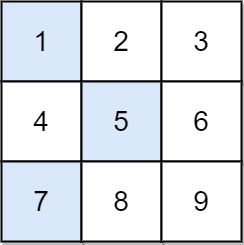Welcome to Subscribe On Youtube
1289. Minimum Falling Path Sum II
Description
Given an n x n integer matrix grid, return the minimum sum of a falling path with non-zero shifts.
A falling path with non-zero shifts is a choice of exactly one element from each row of grid such that no two elements chosen in adjacent rows are in the same column.
Example 1:

Input: grid = [[1,2,3],[4,5,6],[7,8,9]] Output: 13 Explanation: The possible falling paths are: [1,5,9], [1,5,7], [1,6,7], [1,6,8], [2,4,8], [2,4,9], [2,6,7], [2,6,8], [3,4,8], [3,4,9], [3,5,7], [3,5,9] The falling path with the smallest sum is [1,5,7], so the answer is 13.
Example 2:
Input: grid = [[7]] Output: 7
Constraints:
n == grid.length == grid[i].length1 <= n <= 200-99 <= grid[i][j] <= 99
Solutions
-
class Solution { public int minFallingPathSum(int[][] grid) { int n = grid.length; int[][] f = new int[n + 1][n]; final int inf = 1 << 30; for (int i = 1; i <= n; ++i) { for (int j = 0; j < n; ++j) { int x = inf; for (int k = 0; k < n; ++k) { if (k != j) { x = Math.min(x, f[i - 1][k]); } } f[i][j] = grid[i - 1][j] + (x == inf ? 0 : x); } } int ans = inf; for (int x : f[n]) { ans = Math.min(ans, x); } return ans; } } -
class Solution { public: int minFallingPathSum(vector<vector<int>>& grid) { int n = grid.size(); int f[n + 1][n]; memset(f, 0, sizeof(f)); const int inf = 1 << 30; for (int i = 1; i <= n; ++i) { for (int j = 0; j < n; ++j) { int x = inf; for (int k = 0; k < n; ++k) { if (k != j) { x = min(x, f[i - 1][k]); } } f[i][j] = grid[i - 1][j] + (x == inf ? 0 : x); } } return *min_element(f[n], f[n] + n); } }; -
class Solution: def minFallingPathSum(self, grid: List[List[int]]) -> int: n = len(grid) f = [[0] * n for _ in range(n + 1)] for i, row in enumerate(grid, 1): for j, v in enumerate(row): x = min((f[i - 1][k] for k in range(n) if k != j), default=0) f[i][j] = v + x return min(f[n]) -
func minFallingPathSum(grid [][]int) int { n := len(grid) f := make([][]int, n+1) for i := range f { f[i] = make([]int, n) } const inf = 1 << 30 for i, row := range grid { i++ for j, v := range row { x := inf for k := range row { if k != j { x = min(x, f[i-1][k]) } } if x == inf { x = 0 } f[i][j] = v + x } } return slices.Min(f[n]) }